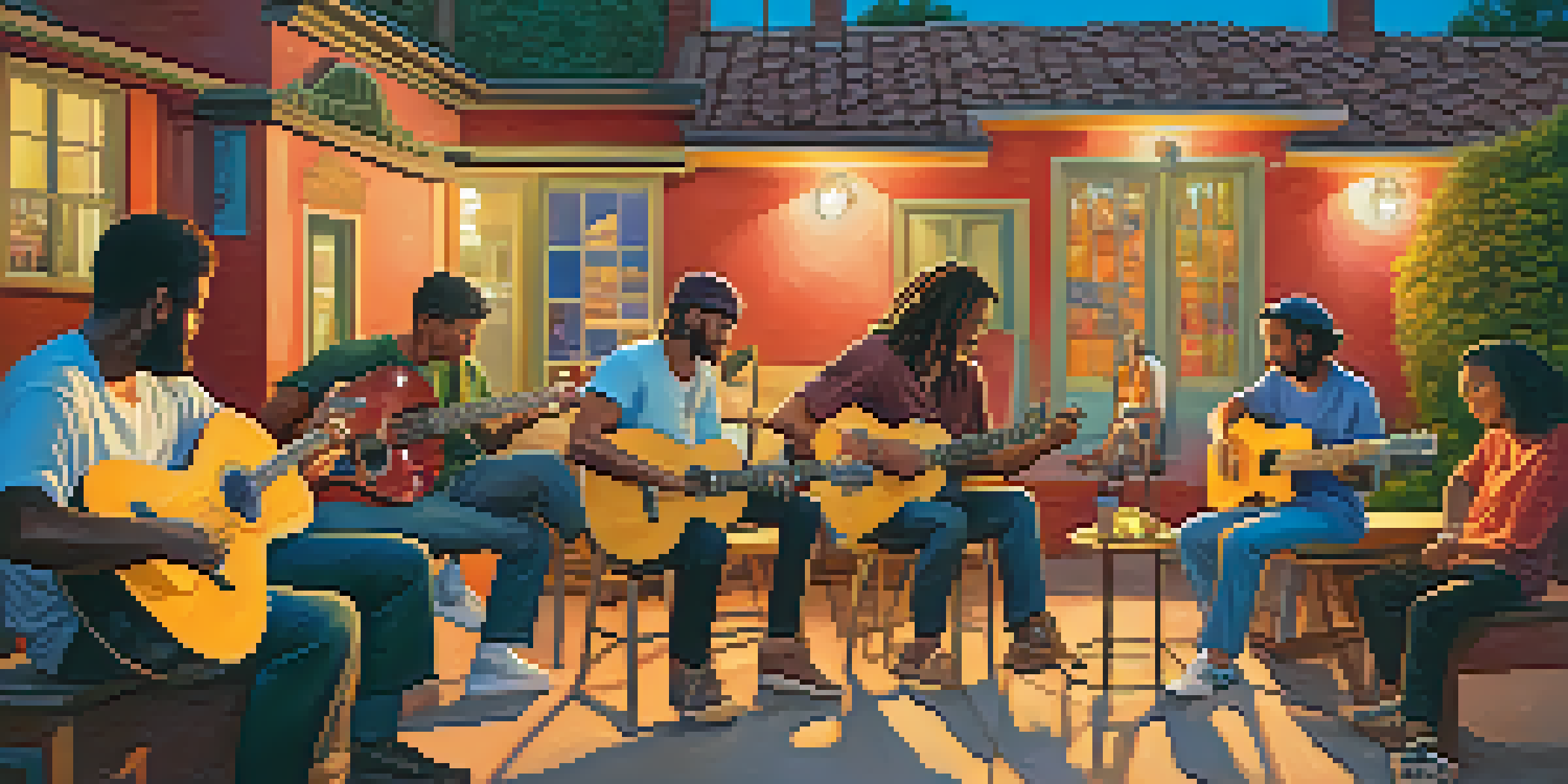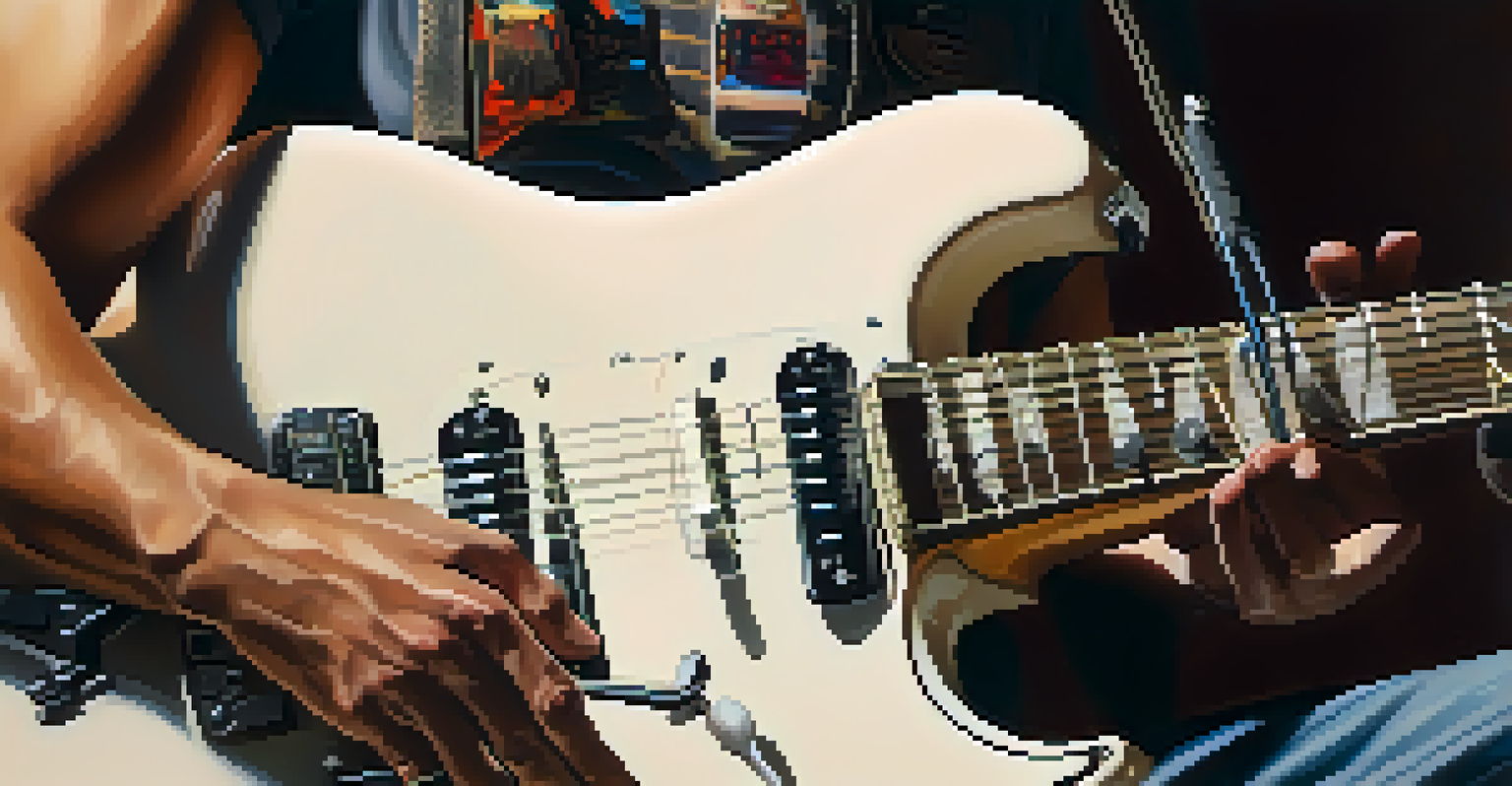The Rise of Virtual Jamming: Guitar Collaboration Tools

Understanding Virtual Jamming: A New Era in Music
Virtual jamming refers to the ability for musicians to collaborate online in real-time or asynchronously, breaking geographical barriers. With advancements in technology, it has become easier for guitarists to connect and create music together, no matter where they are located. This shift has transformed traditional jamming, allowing artists to sample each other’s styles and techniques.
Music brings people together, no matter where they are in the world.
Imagine a musician in New York jamming with another in Tokyo, sharing riffs and ideas instantaneously. This not only enhances creativity but also fosters a sense of community among guitarists worldwide. The convenience of virtual collaboration means that players can work around their schedules, making it more accessible than ever.
As we delve deeper into this topic, we’ll explore the tools and platforms that are making virtual jamming a reality and how they are helping musicians thrive in a digital landscape.
The Technology Behind Virtual Jamming Tools
At the heart of virtual jamming are various technologies that facilitate real-time collaboration. Tools like JamKazam and Soundtrap utilize low-latency audio streaming to ensure that musicians can hear each other without noticeable delay. This is crucial for maintaining rhythm and timing, which are essential in music collaboration.

In addition to audio, these platforms often integrate video, allowing musicians to see each other's expressions and body language, adding another layer of connection. By combining these technologies, guitarists can experience a more interactive and engaging jamming session, akin to being in the same room.
Virtual Jamming Breaks Barriers
Musicians can collaborate in real-time across the globe, enhancing creativity and community.
As these technologies continue to evolve, we can expect even more sophisticated features that will enhance the virtual jamming experience, making it an integral part of modern music creation.
Popular Virtual Jamming Platforms for Guitarists
Several platforms have emerged as front-runners in the virtual jamming scene, each offering unique features tailored for musicians. For instance, platforms like JamKazam provide high-quality audio and video capabilities specifically designed for musicians, while others like Soundtrap emphasize collaborative songwriting and production.
The beauty of music is that it transcends boundaries and connects us all.
Additionally, platforms like BandLab offer a community aspect, allowing guitarists to share their work and receive feedback from others. This social interaction can inspire creativity and lead to new collaborations, making it a vibrant space for artists.
These platforms not only help musicians connect but also provide the tools necessary to create professional-quality music together, regardless of their physical locations.
Benefits of Virtual Jamming for Guitarists
One of the primary benefits of virtual jamming is increased accessibility. Musicians no longer need to rely on local resources or wait for their friends to be available; they can connect with players worldwide instantly. This opens up a wealth of opportunities for learning and collaboration, enriching the guitarist's experience.
Moreover, virtual jamming allows artists to experiment with different genres and styles by collaborating with musicians from diverse backgrounds. This cross-pollination of ideas can lead to innovative musical creations that might not have occurred in a traditional setting.
Tech Tools Enhance Collaboration
Platforms like JamKazam and Soundtrap provide low-latency audio and video, making virtual jamming possible.
Finally, these tools facilitate continuous learning and growth, as guitarists can receive instant feedback and tips from peers, enhancing their skills and musical knowledge.
Challenges Faced in Virtual Jamming
Despite its advantages, virtual jamming is not without challenges. Latency issues can sometimes disrupt the flow of music, making it difficult for musicians to stay in sync. While many platforms are working to minimize this, it remains a common hurdle that needs addressing.
Additionally, the technical know-how required to set up and use these tools can be intimidating for some guitarists. Learning to navigate software and hardware setups can take time, and not all musicians are tech-savvy.
Lastly, while virtual collaboration can be fulfilling, it can also lack the organic chemistry of in-person jam sessions, which some musicians may miss. Finding the right balance between virtual and physical interactions is key.
The Future of Virtual Jamming in Music Collaboration
As technology continues to advance, the future of virtual jamming looks promising. We can anticipate improvements in audio quality, reduced latency, and more intuitive interfaces that will enhance the user experience for guitarists. These innovations could make virtual collaboration as seamless as meeting in person.
Moreover, the rise of artificial intelligence in music technology could introduce new tools for musicians, such as AI-generated backing tracks or real-time composition suggestions. This could take virtual jamming to new creative heights, allowing guitarists to explore uncharted musical territories.
Challenges in Virtual Music Sessions
Latency issues and the lack of in-person chemistry can hinder the virtual jamming experience.
Ultimately, as more musicians embrace these tools, we can expect a flourishing ecosystem of collaboration, creativity, and innovation that redefines how music is made.
Getting Started with Virtual Jamming: Tips for Guitarists
If you're looking to dive into virtual jamming, starting with the right tools is essential. Research various platforms to find one that fits your needs, whether you want high-quality audio, collaborative songwriting features, or a community vibe. Many platforms offer free trials, so you can test them out before committing.
Once you've chosen a platform, ensure your setup is optimized for sound quality. Investing in a good microphone and audio interface can significantly enhance your experience and help you sound your best during collaborations.

Finally, don’t hesitate to reach out to fellow musicians and propose jam sessions. The virtual music community is welcoming, and you’ll likely find others eager to collaborate and share their musical journeys.